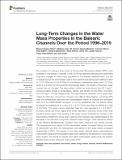Por favor, use este identificador para citar o enlazar a este item:
http://hdl.handle.net/10261/320868COMPARTIR / EXPORTAR:
 SHARE SHARE
 CORE
BASE CORE
BASE
|
|
| Visualizar otros formatos: MARC | Dublin Core | RDF | ORE | MODS | METS | DIDL | DATACITE | |

| Título: | Long-Term Changes in the Water Mass Properties in the Balearic Channels Over the Period 1996–2019 |
Autor: | Vargas-Yáñez, Manuel; Juza, Mélanie; García-Martínez, María del Carmen; Moya-Ruiz, Francisca; Balbín, Rosa; Ballesteros-Fernández, Enrique; Muñoz, María; Tel, Elena CSIC ORCID ; Pascual, Josep; Vélez-Belchí, Pedro CSIC ORCID; Salat, Jordi CSIC ORCID | Palabras clave: | Centro Oceanográfico de Málaga Medio Marino |
Fecha de publicación: | 2021 | Citación: | Frontiers Marine Science, 8. 2021: 1-17 | Resumen: | The analysis of a 24-year time series of Conductivity-Temperature-Depth (CTD) casts collected in the Balearic Channels (1996–2019) has allowed detecting and quantifying long-term changes in water mass properties in the Western Mediterranean. For the complete period, the intermediate waters have experienced warming and salting at rates of 1.4°C/100yr and 0.3–0.6/100yr for the Western Intermediate Water, and 1°C/100yr and 0.3–0.4/100yr for the Levantine Intermediate Water. The density of these two water masses has not changed. The deep waters, defined as those denser than 29.1 kg/m3, showed positive trends in temperature, salinity, and density (0.8°C/100yr, 0.2/100yr, and 0.02 kg.m–3/100yr, respectively). The high temporal variability of the upper layer makes the detection of long-term changes more difficult. Nevertheless, combining CTD data with temperature data from the oceanographic station at L’Estartit and simulated data from the NCEP/NCAR reanalysis, it can be established that the Atlantic Water increased its temperature at a rate of 2.1–2.8°C/100yr and likely its salinity at a rate of 0.6/100yr. The water column absorbed heat at a rate equivalent to 1–1.2 W/m2. All these trends are much higher than those reported in previous works (more than double in some cases). The warming of the water column produced an increase in the thermosteric component of sea level. However, this increase was compensated by the decrease in the halosteric component. Besides these changes, other alterations related to the Western Mediterranean Transition have been observed over shorter periods. The temperature and salinity of the intermediate waters increased before the winter of 2004/2005 and then the temperature and salinity of the deep waters increased dramatically in 2005. The density of the deep water reached values unprecedented before 2005. Deep and intermediate waters were uplifted by the presence of such dense deep waters. The arrival of warmer and saltier intermediate waters from the Eastern Mediterranean is also observed, mainly after 2010. | URI: | http://hdl.handle.net/10261/320868 | DOI: | 10.3389/fmars.2021.640535 | ISSN: | 2296-7745 |
| Aparece en las colecciones: | (IEO) Artículos |
Ficheros en este ítem:
| Fichero | Descripción | Tamaño | Formato | |
|---|---|---|---|---|
| 2021_Vargas_water mass_sea level_balearic.pdf | 4,57 MB | Adobe PDF |  Visualizar/Abrir |
CORE Recommender
SCOPUSTM
Citations
10
checked on 29-abr-2024
WEB OF SCIENCETM
Citations
8
checked on 28-feb-2024
Page view(s)
17
checked on 07-may-2024
Download(s)
12
checked on 07-may-2024
Google ScholarTM
Check
Altmetric
Altmetric
Este item está licenciado bajo una Licencia Creative Commons

